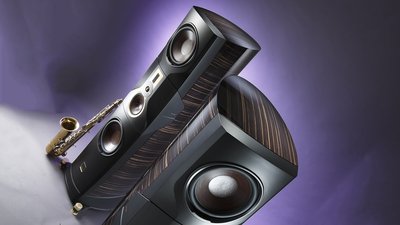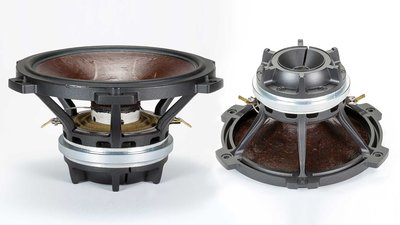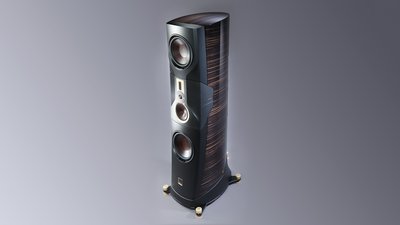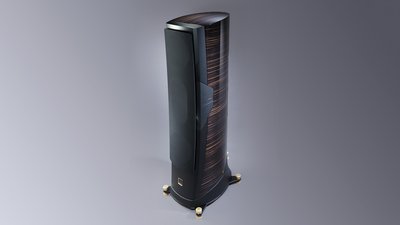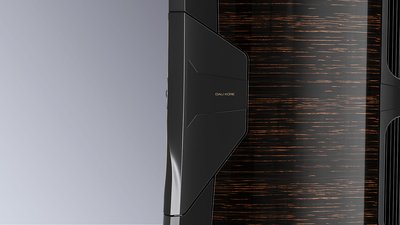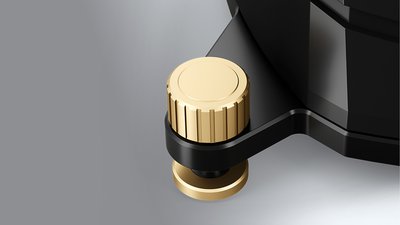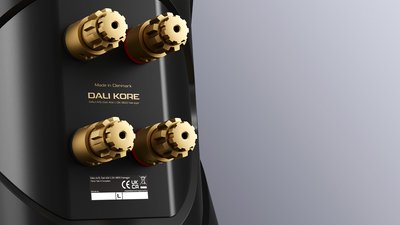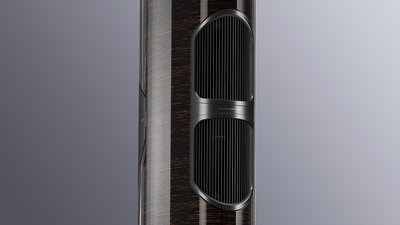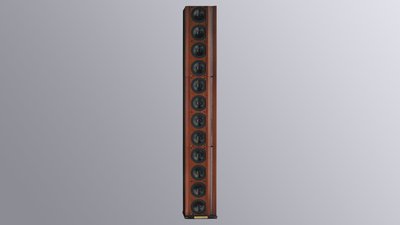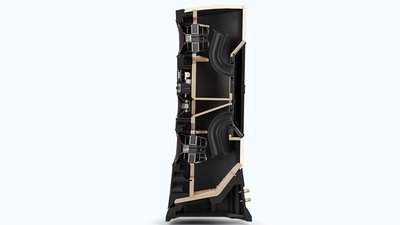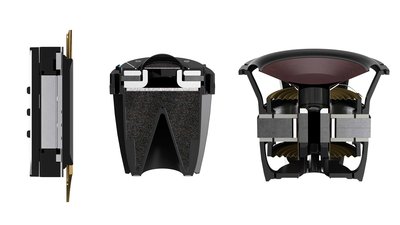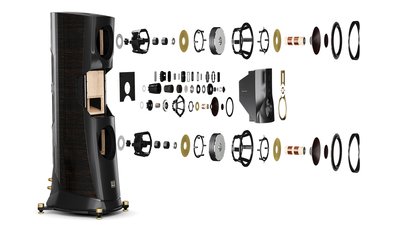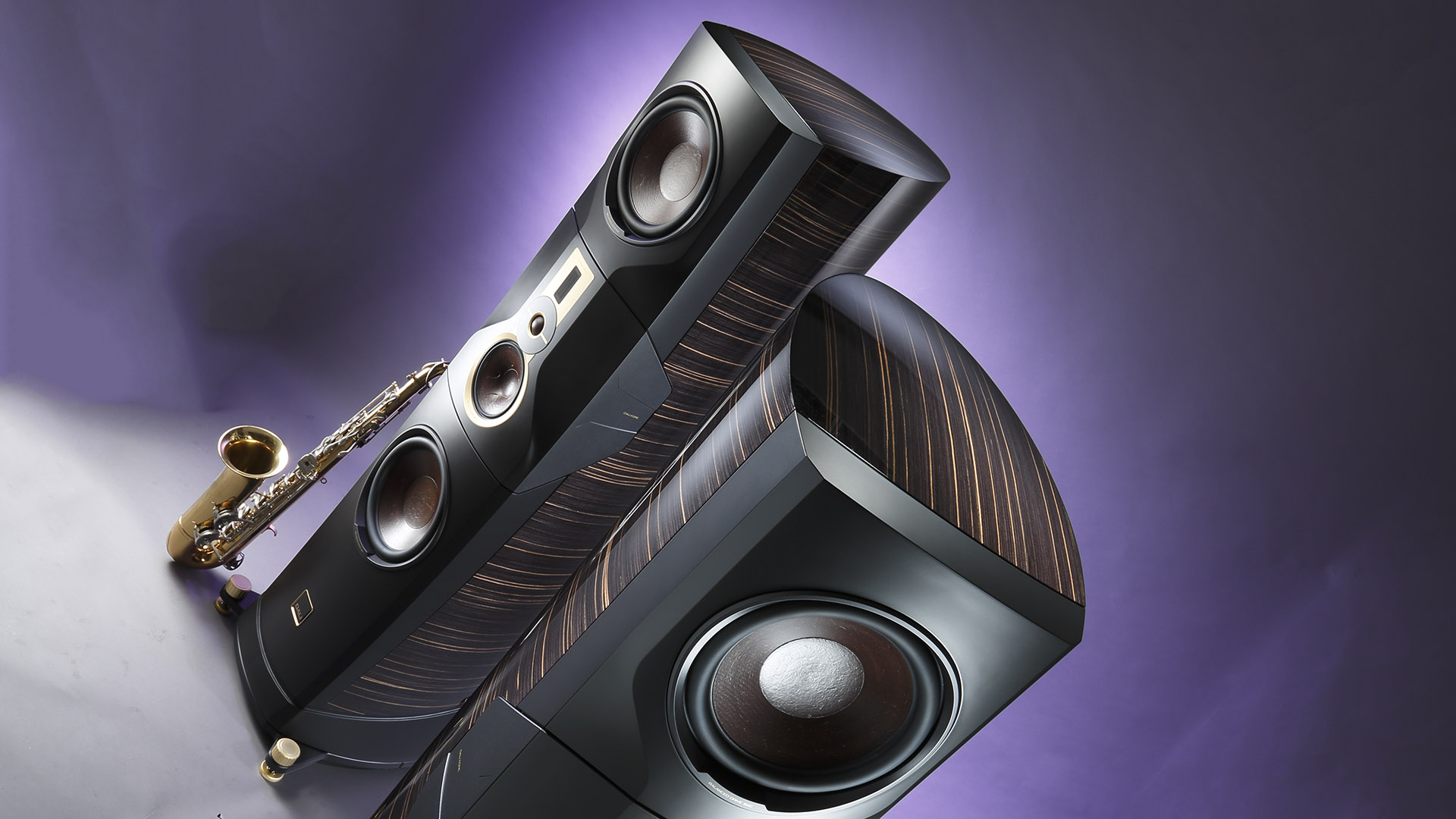
Floorstanding Speaker Test
DALI KORE Review
Danish loudspeaker giant DALI had promised a state-of-the-art loudspeaker at the press event in Munich‘s MOC. After the presentation of the DALI Kore, in a rare moment of complete agreement, the guests left the room with a big smile on their faces.
HighEnd audio show, May 2022, Munich, Germany – for someone from the press, this equates to four hectic days, a race against time to discover as many exciting new products as possible, to have them explained to you and to get hold of at least a couple of short listening sessions from a suitable sitting position.
Despite these circumstances, the DALI showroom was packed with press representatives when CEO Lars Worre and his team explained the background and aspirations of the Kore. This was quite necessary, considering that DALI is known for a down-to-earth pricing of its loudspeakers. Thus, it was not necessarily expected that they present a colossus weighing around 140 kilograms with an impressive height of 170 centimeters and a pair price of 80,000 euros. There is indeed no real shortage of high-priced speakers from small manufacturers.
And finally, a good 25 years have passed since the presentation of the Megaline, with which the Danish loudspeaker manufacturer first astonished the high end audiohpiles of this world in 1996. The price of the Megaline amounted to around 44,000 euros per pair when production was finally discontinued in 2012.
However, there is not only a large gap between its predecessor and the Kore in terms of pricing and time, but also in terms of technology. After briefly reading the white paper, it becomes clear that 25 years is plenty of time to turn thoughts about improvements for the sound into specific measures and ultimately a market-ready product. Despite rumors claiming the contrary, there has been a great deal of progress, some of it very significant, in the reproduction of music via appropriate devices and loudspeakers.
The Personal Aspiration
The self-imposed standards connected with this goal were filled with numerous obstacles, which led to the fact that development took significantly more time than originally calculated. Not only the cabinet with its curved shape consisting of many layers of birch wood required extraordinary ideas, but combining it with the concrete base and the midrange/tweeter unit integrated into a solid aluminum block was also a challenge. It was solved by, among other things, a five-axis, computer-controlled milling machine and a painting system that applies and dries the very hard, yet environmentally friendly paint quickly and precisely.
Even the crossover did not find favor in the ears of the developers until various components were designed specifically for this speaker. Another task was to manufacture as much as possible in-house and to use suppliers in the region around the company‘s headquarters in Nørager on top of that. The image with the speakers cut open illustrates the complexity of Kore.
Conservative & Conventional?
The drivers admittedly look somewhat conservative and conventional when installed. Before we get to them, however, a brief note should be made concerning the assembly challenges created by the weight of the speaker and individual components: Thus, it was necessary to think about additional equipment ranging from pulleys to rotating plates in order to put everything together correctly. And all that without a single screw being visible! The fact that the loudspeaker comes in one piece and not in several parts as a „kit“ also required a few ideas in terms of packaging. A ramp was designed and wheels were attached to the speakers so that they could be moved to their final position, for example.
But now, let‘s move on to the heart of this loudspeaker, reminiscent of a Formula 1 racing car in its complexity and the inevitably perfect interplay of each individual component – the drivers. Here, the developers demanded a significant reduction of distortion of all kinds, higher efficiency, increased power handling for extreme dynamic capabilities, a wide and uniform dispersion angle to get the full sound experience even off-axis, a perfect impulse response and much more.
And – the advantage gained when developing and manufacturing drivers yourself – a driver layout that makes it possible to ensure harmony and a perfect division of labor with relatively few, but extremely high-quality components.
It Started With The Bass
Let‘s start with the two woofers, each sporting around 30 centimeters in diameter and playing in a ported system to a total volume of a respectable 144 liters. They are optimized in their characteristics and their relation to the other drivers of the Kore for a listening distance of three meters. Considering the air volume behind the woofers and the midrange driver, the design and shape of the speakers came almost automatically, according to DALI – form follows function at its best, one might say. The special feature of the drivers is that the voice coils, which are particularly large at 60.7 millimeters, are available twice per driver and also have a separate spring damping at the upper and lower ends, respectively. Both the woofers and the midrange are built with a special magnet system, with different distances to the voice coil, but sharing the same magnet. In the case of the midrange driver, this is made of neodymium, while the woofers have two ferrite magnets joined together each.
The voice coil gaps, one on each side of the magnet, have opposite magnetic field directions. That means that the respective voice coils must conduct current in opposite directions to generate kinetic force into the same direction.
This symmetrical design is based on a patent from the 70s, which – as far as we know – has not been realized up until now due to its complexity. It reduces distortion and any compression effects to a considerable extent. In the case of the Kore, the innovation is that this technology has been combined with SMC, a granule with tiny independent magnetic particles. These generate an extremely high magnetic flux density of more than 1 Tesla, while the electrical conductivity is about 1/25000 of iron and has been reduced by a factor of two and a half compared to the 1st generation SMC. These technical aspects ensure that the common pole piece becomes "magnetically permeable". That in turn means that the modulation of magnetic flux caused by the movement of the voice coil is „transmitted“ into the pole piece (the core) between the opposing motor systems in antiphase. Thus, according to DALI, the cancellation of nonlinearities by this technology – named "Balanced Drive SMC", – is supposed to occur over a much wider frequency range and a wide variety of levels.
In more conventional drive systems, the heat generated by high loads causes the resistance of the voice coil to increase significantly. And of course, new discoveries have also been incorporated into the research and development concerning further aspects of a driver, such as membrane material, surround and basket.
Similar, but Different
The midrange driver – which looks like a scaled-down version of the woofers – employs, among other things, a titanium voice coil former. The energy supplied to it is converted cleanly and quickly into sound by a stiff yet lightweight diaphragm and a weight-optimized surround. The unwanted sound radiation towards the rear is neutralized by a transmission line sound guide without affecting the dynamic response negatively in the process.
In the high-frequency range, the Danish designers rely on an evolution of the hybrid dome/ribbon tweeter unit they‘ve been using since the 1990s. But here, too, they didn‘t settle with taking something that was already there, but developed a new 35 mm dome tweeter that plays in the range from 2.1 kilohertz up to 15,000 hertz. Above that, the ribbon then takes over. The ultimate level of detail and smooth, distortion-free sound were development goals here as well, which were also achieved by lowering the resonant frequency to a harmless range. High efficiency and virtually no compression effects are also mentioned here as an additional benefit.
Music, Music, Music
The large floorstanding speaker more than impressively demonstrated its musical qualities after a proper warm-up time as well as an intense search for the optimal placement position and fine-tuning of other components and cables. In order to achieve maximum homogeneity and plasticity, we had to angle the Kore to the listening position.
The moment Hans Theessink and Terry Evans performed "Delta Time", the jaws of the listeners inevitably started to drop, while a rarely experienced sparkle entered the eyes of the audience. The reason for this was to be found in an extremely rarely experienced mixture: unbelievably three-dimensional, powerful and dynamic reproduction at low as well as adventurously high levels paired with the truly authentic timbres of voice and guitar. This being so close to the real live experience is only made possible when development and production were very careful to pay attention to apparent trivialities. With that, the sound image is just as correct in terms of tonality as in the almost holographic spatial imaging and the absolutely certain sense of perfect timing.
At all times, the Kore managed to extract the emotions in the music with playful ease. Supported by a powerful and precise bass foundation, the Danish loudspeaker monsters nevertheless managed to disappear in the listening room – at least as far as the sound was concerned, which seemingly appeared out of nowhere.
Sudden Impulses
In "Still Waters Run Deep", Carolin No reinforced these impressions with her blend of electronic and impulsive bass sounds, piano and delicate voice. The performance was crisply clean, but in no way sterile or unnaturally overdamped, the sounds spread out into the room with wonderful ease. Furthermore, the acoustic qualities of the speakers stood in contrast to their room-filling looks, as was also emphatically demonstrated in "The Forest" by Trentemöller.
But your record collection, just like mine, fortunately does not only consist of sonic gems, but – at least I hope so – of music that we love or that we have perhaps grown fond of over the years. For a "local patriot" of the city of Cologne like myself, this obviously includes the most „Kölsch“ of all Cologne bands. I‘m of course talking about the Bläck Fööss, who recorded an album with new interpretations of classics from their repertoire with many guests to mark the band‘s recent 50th anniversary.
"Dat Wasser vun Kölle" comes along with a gospel sound now, featuring a rap intro by the Beer Bitches, the band around comedian Carolin Kebekus. Over a mediocre stereo, the spoken words are hardly understandable. Over the DALI, it‘s completely different, however: you can understand every single word – probably even if you don‘t speak the local dialect.
Dynamics Redefined
Afterwards, we listened to four instruments played with virtuosity in excellent sound quality: tenor saxophone, piano, double bass and drums of the Johnny Griffin Quartet. As skilfully as easily, the musicians proved that jazz is by no means only music for the brain, but that rhythm and feeling are elementary components of this genre.
You will search long and in vain for more premium funk than Maceo Parker‘s performance in Cologne‘s Stadtgarten in March 1992. The pure energy of those evenings – found on the the "Life On Planet Groove" album – is delivered completely effortless into the listening room by the DALI, even at breathtaking, live-like levels. The heat, which downright boiled the concert hall on a cold March evening, made us forget that we‘re listening to something pre-recorded as long as the record was playing. And we were constantly aware of the fact that even at levels above 100 decibels, we were far from pushing the DALI to its limits. The unbelievable effortlessness and complete transparency down to the lowest bass frequencies, with which the rhythmically intricate and detail-filled "Soul Power ´92" of the nine-member line-up sounded, was simply sensational and not yet experienced in our listening room up to that point.
Delightful Voices
Following that, we listened to "Carmen" under Lorin Maazel with Julia Migenes and Placido Domingo, a recording from 1984. Of course, dynamics, authentic reproduction of the entire frequency spectrum and presentation of details are important criteria for an orchestra as well. Here, however, high demands for credible, physical voice reproduction and high tonal fidelity of instruments as well as solo and choral voices were added to that. In addition, the voices are also supposed to be distinctly detached from the orchestra. The depicted stage was large and perfectly to scale in terms of width, height and depth – broad grins and incredulous head shaking were unavoidable. It was like "taking a bath in the music" as might be experienced with a select few big line-source speakers, if you‘re lucky. The release of happiness hormones occurred to a degree that is only rarely experienced; goosebumps, foot tapping and occasionally watery eyes alternated.
A striking feature of the Kore is its amazing lack of discoloration. We wondered whether the so far absolutely flawless performance of the Danish super-speakers could be convicted of sloppiness or even faultiness at any point.
In Search of Weaknesses
Long story short: We simply couldn‘t. Even despite the fact that, over the few weeks in which we were fortunate enough to spend time with these speakers, we listened to pretty much every mean record or CD we could get our hands on. That included Dizzy Gillespie with "Riviera", „Dafös“ featuring the destruction of a drum kit, Deep Purple‘s "Highway Star" and Martha Argerich collaborating with Itzhak Perlman, who proved that they are absolutely exceptional on the grand piano and violin, respectively.
The DALI Kore belongs to the very small group of super loudspeakers that can hardly be assessed by normal standards or even judged using percentages and stars. Its sound is a magnificent experience from start to finish, such as we have only experienced extremely rarely – but mostly in even more uncomfortable price ranges. The speaker‘s dimensions and weight will however prevent them from moving into most of the apartments or houses of music enthusiasts. The same is true for their price, which is far out of reach for the vast majority of people.
We are thus left with the hope that the Danes will soon succeed in transferring a large part of the technology and sound of this groundbreaking product into more tolerable size and weight classes. And bring the price into regions that can be reached with some saving up. With a heavy heart, we let this dream of a loudspeaker go again.
Verdict
A dream of a loudspeaker, such as is very hard to find. Large and powerful in appearance, sonically mastering every register between delicate details and opulence. The brilliant workmanship and the tremendous depth of development explain the price, which in comparison, however, seems somewhat low.
Technical Details
Floorstanding speakers (passive)
DALI Kore
Price: ca. 80000 € (Last check: 22.09.2022)
Dimensions WxHxD: 51 x 171 x 67 cm
Weight: 140 kg
Warranty: 5 years
Manufacturer: DALI GmbH
General Data
Measurement Results
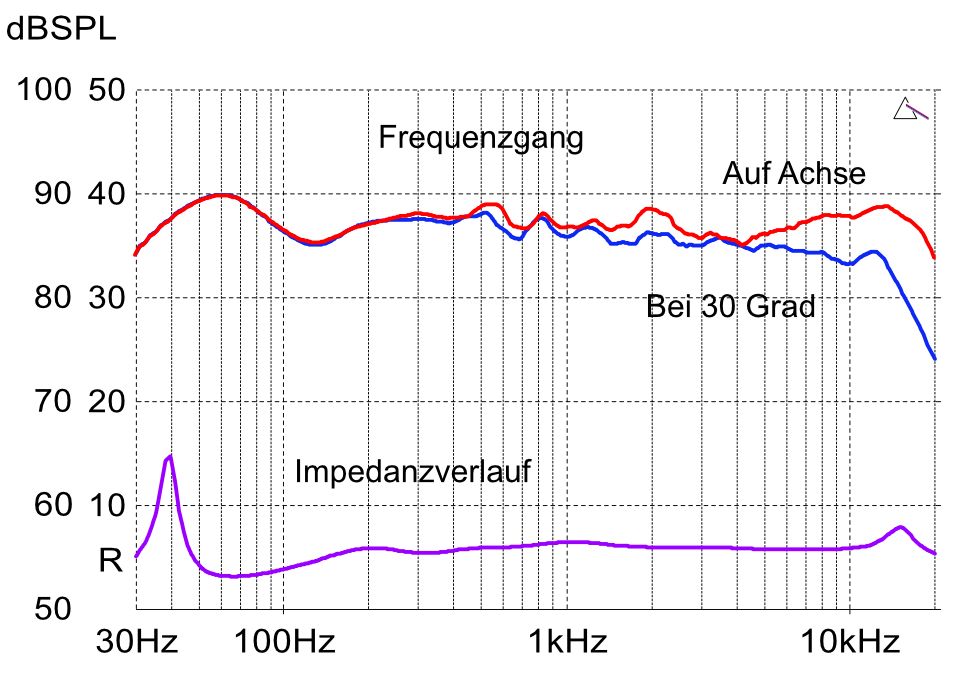
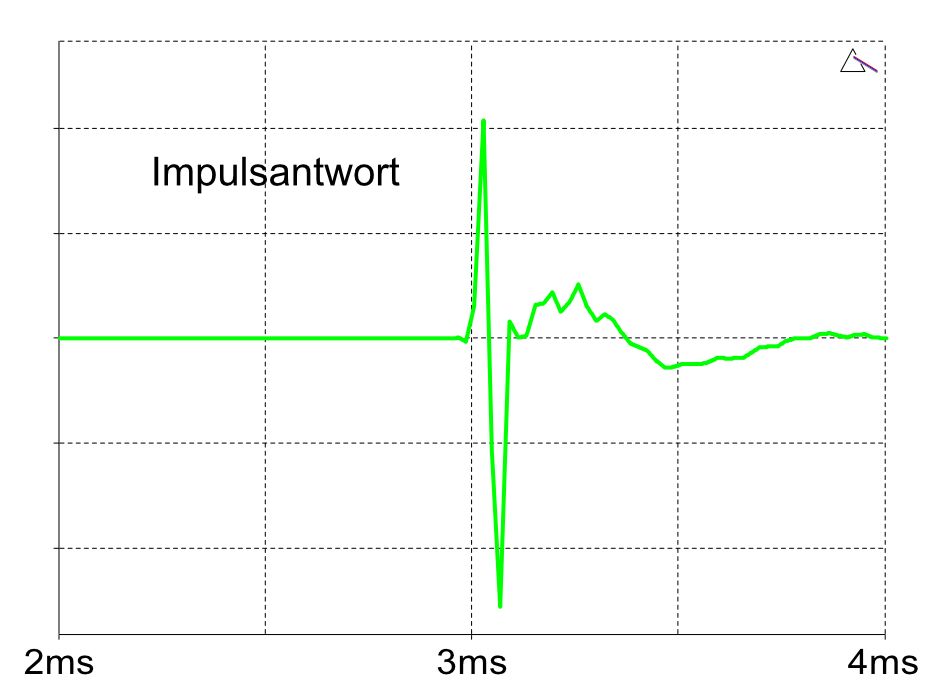
Measurement Values
| Rated impedance at DC: | 4 Ohm |
| Minimum impedance: | 3.3 Ohm |
| Minimum impedance at: | 65 Hz |
| Maximum impedance: | 15.1 Ohm |
| Maximum impedance at: | 40 Hz |
| Sound pressure characteristic (2.83 V/m): | 86.2 dBSPL |
| Power for 94 dBSPL: | 12.9 W |
| Lower cut-off frequency (-3dBSPL): | <32 Hz |
| Distortion factor at 63/3k/10k Hz: | 0.12/0.07/0.11 % |
Lab Comment
Balanced frequency response, very good impulse response, extremely low distortion even in the bass; medium efficiency.
Features
Four-and-a-half-way ported loudspeaker. Spikes adjustable in height from above, magnetically adhering disks; removable cover; solid bi-wiring terminal.
Test Devices
Turntables:
Transrotor Rondino / Transrotor Strato
Streamer/CD Player:
T+A MP 3100
Preamps:
Octave HP 300 SE,
Accustic Arts Tube-Preamp II
Phono Preamps:
Nagra Classic Phono,
Audionet PAM G2
Power Amps:
Accustic Arts AmpII MK4,
Krell Duo 300 XD,
T+A M200,
NAD M23 (4x Monoblock)
Loudspeakers:
PMC fact.12 Signature,
B&W 801 D4
Cables:
AudioQuest, Cardas, HMS,
Inak, Stockfisch, Supra
What we‘ve Heard
Bizet: Carmen
Among the countless recordings, this one with Julia Migenes and Placido Domingo stands out thanks to its vocals.

Bläck Fööss: 50
Well-known songs by the mother of all Cologne bands in exciting new shapes.
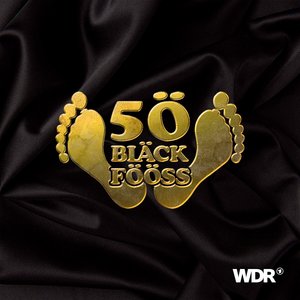
Keyword SMC
Soft Magnetic Compound granules that are strongly magnetic while barely electrically conductive, which greatly reduces distortion.
 MAGAZINE
MAGAZINE